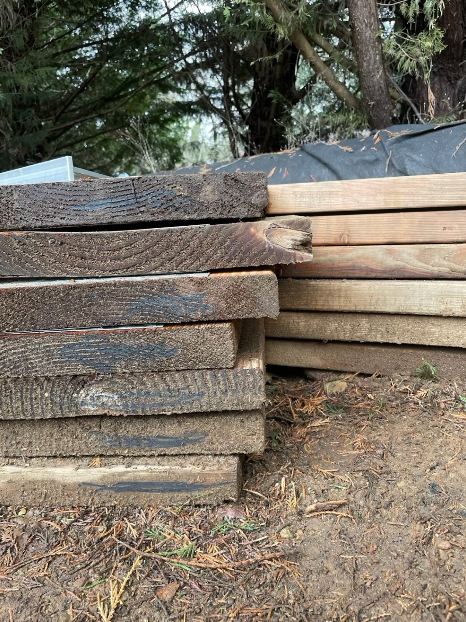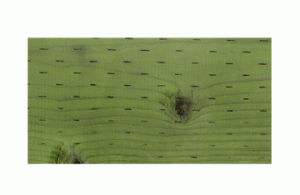In prior posts, I’ve mentioned phenol-resorcinol glues. When it comes to putting two or more pieces of wood together (like a glu-laminated column), this combination just can’t be beat for both performance and cost effectiveness.
For those who want to be “in the know”, here is the straight scoop!
 WARNING: Failure to have aced high school chemistry could result in head nodding and saying, “Yep, sounds like some great stuff” (which it is).
WARNING: Failure to have aced high school chemistry could result in head nodding and saying, “Yep, sounds like some great stuff” (which it is).
PRF adhesives are classified as thermosetting polymers and are produced by a condensation polymerization between formaldehyde, phenol and resorcinol.
PRF adhesives are cold-setting with very high weather and water resistance as well as heat resistance to be used in products for exterior, humid and interior climates. PRF adhesives can also be used in hot bonding and radio frequency curing equipment to speed up the curing process.
PRF adhesives are mainly used in the production of load-bearing timber structures (such as for glu-laminated beams and columns) where a maximum of weather resistance is required. With a proven track record such as this, these adhesives have developed a long and successful history of use in plywood and timber laminating. Unlike the epoxy family of adhesives, PRF’s are completely UV-resistant, outlasting epoxies in high-weather-exposure applications almost ten to one.
G-1131 (also called Penacolite or Cascophen, used in structural wood “glue-lam” beams) is a representative commercial product.
There are three key constituents of this complex and proven adhesive system.
Also called benzophenol or carbolic acid, phenol is derived from the oxidation of cumene, a petroleum by-product. It may be readily recognized as the prefix of “Phenolic” as in phenolic plastics and as one of the chief constituents in epoxy.
In its pure form, formaldehyde is a gas with a strong pungent odor and is derived through oxidation of hydrocarbons such as methanol, propane or butane in the presence of a catalyst. It is commercially offered as a 37-50% aqueous solution, called Formalin that usually contains up to 15% methanol to inhibit polymerization.
Resorcinol (also called “Resorcin”) is the 1,3-isomer of benzenediol. Resorcinol, is produced by sulfonating benzene with fuming sulfuric acid and fusing the resulting benzenedisulfonic acid with caustic soda. Interestingly, resorcinol is often used in polyurethane resins and other coatings as a UV absorber.
The earliest commercial synthetic resin based on a Phenol formaldehyde resin is sometimes called phenolic and had the commercial name Bakelite. It is formed from an elimination reaction of phenol with formaldehyde.
Phenol is highly reactive towards formaldehyde which attaches directly to the phenol ring structure. This forms a hydroxymethyl phenol, which is not usually isolated in novolacs but is found in resoles. The hydroxymethyl group is capable of reacting with either another free ortho or para site, or with another hydroxymethyl group. The first reaction forms a methylene bridge, and the second forms an ether bridge.
Base-catalyzed phenol formaldehyde resins are made with a formaldehyde to phenol ratio of greater than one (usually around 1.5). Phenol, formaldehyde, water and catalyst are mixed in the desired amount, depending on the resin to be formed, and are then heated. The first part of the reaction, at around 70 °C, forms hydroxymethyl phenols. This results in a thick reddish-brown resin.
The rate of the base-catalyzed reaction initially increases with pH and reaches a maximum at approximately a pH = 10. The reactive species is the phenolic anion formed by deprotonation of phenol. The negative charge is delocalized over the aromatic ring, activating sites 2, 4 and 6, which then react with the formaldehyde.
Formaldehyde in solution does not exist as the aldhehyde, but instead a dynamic equilibrium is formed creating a range of methylene glycol oligomers, and the concentration of the reactive form of formaldehyde depends on the exact conditions (temperature, pH) under which the reaction occurs. Thus the reaction rate law describing phenol and formaldehyde is not a simple one, and the chemical kinetics are highly complex.
Hydroxymethyl phenols will crosslink on heating to around 120 °C to form methylene and methyl ether bridges. At this point the resin is starting to crosslink, to form the highly extended 3-dimensional web of covalent bonds which is typical of polymerized phenolic resins.
It is this highly cross-linked nature of phenolics which gives them their hardness and their excellent thermal stability and which makes them impervious to most chemical attack. It is also the reason they are called thermosets.
Well, you can’t say I didn’t warn you. I think even my wife’s son who teaches Chemistry and Physics in Tennessee would be impressed! For Jake and all those who want to know all about PRF adhesives, enjoy!









We require PRF glue for timber Finger joining